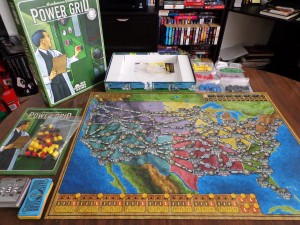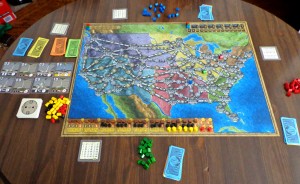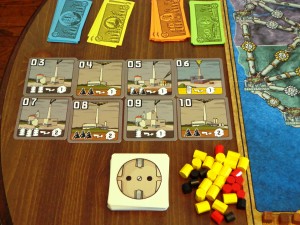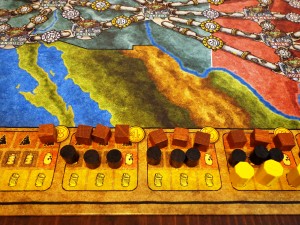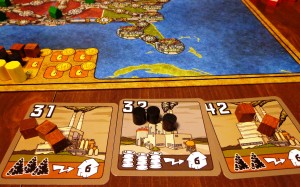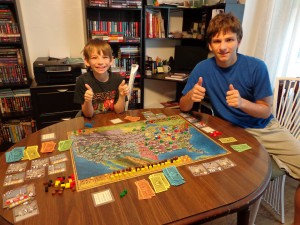If you’ve ever played SimCity for the SNES, you’d know that power plants are necessary to grow your city into a megalopolis. Of course, it wouldn’t be SimCity if you’ve never tagged Bowser in to defecate all of your sweat and tears shortly after reaching that 500,000 population mark.
Power Grid takes the general idea of buying power plants to power cities to a whole new level. Players will be buying power plants, the resources needed to power them, and building a network of cities together in the most efficient way possible. Let’s take a quick look at the components and gameplay before heading into the review.
Components
Board – The board is two sided…one side displays the USA and the other shows a map of Germany. Each side has a space for the resource market, the player order track, and the scoring track. Each map is split up into regions which are notably different via their background color.
Houses – Each player receives houses of their color, which are placed on the board to represent which cities they’ve connected throughout the game.
Resources – Coal (brown), oil (black), garbage (yellow), and uranium (red) make up the resources that players will be purchasing to operate their power plants.
Money – “Elecktro” is your form of currency in this game and is used to purchase power plants, buy resources, and place your house pieces on cities to connect them.
Cards – “Summary Cards” are available to help guide players through the game. “Power Plant Cards” are purchased and used to power your cities. The number in the top left of a power plant card is the initial cost of purchasing the power plant and the art along the bottom tells players how many resources of a particular type are needed to power so many cities. The “Step 3” card signals the approach of the end of the game, but more on that later.
Setup
First, players will seed the resource market with twenty-four coal, eighteen oil, six garbage, and two uranium, placing these resources on the highest numbered block (representing the cost) possible going down.
The 03, 04, 05, and 06 power plant cards are placed horizontally in a row (representing the current market), with the 07, 08, 09, and 10 power plant cards placed underneath them (representing the future market). Players find and set aside the 13 power plant card and Step 3 card for the time being, shuffling the remaining power plant cards. The 13 power plant card is placed on top of the shuffled deck and the Step 3 card is placed on the bottom.
Each player receives fifty Elecktros, a summary card, and the houses of their color. Each player places a house on both the scoring track and the player order track, to be used later. Next, players pick regions that will be used in the game. The amount of regions used depends on how many players are playing. Once regions have been decided on, it’s important to remember that only these regions will be used through the game…the others will be ignored.
The starting player is chosen randomly.
Gameplay
Editor’s Note: The rules and many stages of the game can be confusing to new players. I will do my best to balance the explanation of these rules while trying to keep the review moving. Experienced players should take note, as I may skip or just briefly go over something that is in actuality a bit more involved than what I gave it credit for.
The game is played over three “Steps”, each step slightly changing the way that rounds play out. Step 1 begins right away when the game begins, Step 2 starts when one player connects so many cities, and Step 3 occurs when the Step 3 card is drawn from the deck.
There are five phases in a round and can be summed up as follows:
Phase One: Determine Player Order
At the beginning of every round (except for the very first round) players will look to see who has the most cities and adjust the player order track appropriately. The person with the most cities is designated as the first player and so on and so forth. In case of ties, the person with highest numbered power plant is placed ahead.
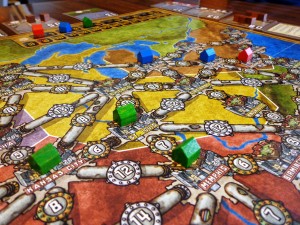
Player order can mean a lot in the later phases of the current round…sometimes being first isn’t always better.
In the first round, no one has cities yet, so this particular phase swaps positions with the next phase…that is…once players have purchased power plants, player order is determined by the numbers on those power plants.
Phase Two: Auction Power Plants
In Steps 1 and 2, the power plant market consists of a total of eight power plant cards. The four power plants on top are the current market, which players can initiate auctions on, and the bottom four represent the future market. Auctions begin with the player that is FIRST on the player order track. This player chooses one of the four top power plant cards and starts the bet, the minimum being the number listed on the top left of the card. Auctions continue (in player order) until all players have acquired a power plant card or passed appropriately, the former being mandatory in the first round. In Step 3, there are only six power plant cards in the market, but they are all available to be auctioned. As auctions are completed, the cards in the market slide around so that the leftmost card in the future market moves up to the current market.
It’s worth noting that players are limited to how many power plants that they can have in their possession…this number changes based on how many people are playing the game.
Phase Three: Buying Resources
Each player will be able to purchase resources from the resource market, starting with the player LAST on the player order track. Players can only purchase resources appropriate to the plants in their possession and only up to double what their power plants need to produce power. If a power plant uses two oil to power so many cities, for example, then it can hold up to four oil.
Players will note that as they buy resources, the cost of those resources go up. Those of you who took economics may recognize the nods to supply and demand.
Phase Four: Building
Starting with the LAST player on the player order track, houses can be placed at a certain cost which fluctuates as the game goes on. The price of connecting cities is determined by how many connections already exist there (via other player house pieces) and the connection cost from one city to another as indicated on the pipes leading from city to city.
In Step 1, players are limited to one connection (house) per city, no matter what color it is. In Step 2, players can build up to two connections per city, the second at extra cost, but one particular color cannot have more than one connection in a city. In Step 3, up to three unique color connections can exist in a city but at additional cost.
Phase Five: Bureaucracy
A few things happen in this phase. First, players operate their plants, trading in resources to power the number of cities they want powered. They then receive Elecktros…the more cities they power, the more Elecktros they get. It’s important that players place the resources they are turning in to the resource pool (off the board) and NOT onto the resource market.
After that, the resource market is restocked via a chart in the manual, always from right to left on the market (most expensive block to least expensive block).
Finally, the highest numbered power plant in the future market is placed on the bottom of the deck and a replacement for it is drawn…if it is Step 1 or 2. If it is Step 3, the lowest numbered plant is removed from the game.
Endgame Conditions
The game ends when a player builds a pre-determined number of connections, which varies based on how many people are playing. The person who has the most POWERED cities wins the game.
As I stated before, the above does not go into detail on everything in the manual. For that, you can view the manual here:
The Review
I’m not going to lie, it took me a bit of time to understand how all of the steps and phases worked with each other. Once I did, however, I really took a liking to the game. I’d recommend that newcomers find someone to play the game with who already knows how to play. If that isn’t possible, set aside some extra time on your first night with your group because you will easily go over the average play time…at least the kids and I did. We clocked in at about three hours, but those three hours weren’t boring at any point during our play experience.
There’s a lot for a player to consider, giving this game a lot of depth. Players have to balance their Elecktros between the auctions, buying resources, and making connections as best they can. Having an abundance of cities with no power plants capable of powering them may be a problem, as would having a ton of power but not enough cities to pull ahead of the others who are quickly expanding their network. On top of all of that, the resource market is constantly changing, based on what power plants are being used by players. If everyone uses oil, for example, they’ll quickly buy it all out or make it so expensive that it just wouldn’t be worth using anymore. Players will be constantly changing and adapting to the decisions that everyone else is making. Not only that, but the limit of power plants one can have will force players to buy more efficient plants as they become available…replacing your oldest plant may not always be the best move however, depending on how the resource market looks and what your plants currently use to power your cities.
Vinnie (11) and Anthony (16) both enjoyed themselves. Vinnie received a crash course in auctioning and I took time out to explain how outbidding by absurd amounts would deplete his Elecktro supply to the point of not being able to do much else. He loved his wind powered plants so much that he grabbed up any that made its way to the current market. At one point, he had the ability to power thirteen cities but only had five connections, not having the Elecktro to build them. However, as he never had to purchase resources, he was building connections like mad toward the end of the game with his surplus Elecktro. Anthony had all uranium power plants and quickly saw that he was buying up more than the market was restocking, so he switched over at the end to the “50” power plant, gobbling it up and powering a ton of cities at no resource cost. I, on the other hand, was buying up coal and oil for cheap as no one else was using it. I was the leader for the majority of the game and took a balanced approach, buying one to two cities every round while buying upgrades (power plants) and resources only when needed. Once I reached a certain point, neither Vinnie or Anthony could stop me.
Overall, I highly recommend Power Grid. In my opinion, it’s worth learning how to play, despite how overwhelming the gameplay mechanics can be at first. With the right coaching and a good amount of patience, younger kids like my eleven year old son can still have a blast powering cities and making connections. Excellent game!
Final Verdict: 9/10

